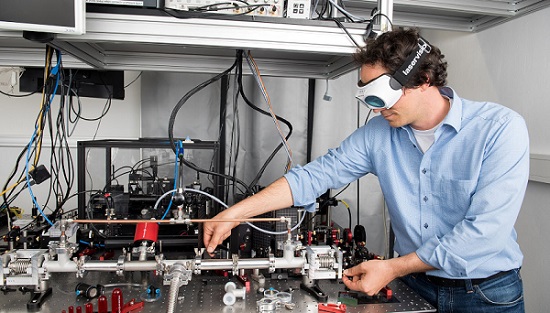Collaborators from industry and academia have demonstrated high-performance laser mirrors in the mid-infrared range that absorb fewer than 10 out of a million photons. The achievement, enabled by recent advancements in optical coating technology, has the potential open applications in medicine and environmental monitoring.
The coating process involves the deposition of single-crystal stacks of high-purity semiconductor materials via an epitaxial growth process. The monocrystalline multilayers that are produced are then transferred onto curved silicon optical substrates by a proprietary bonding process. The completed mirrors were tested at both the Christian Doppler Laboratory (CDL) and NIST.
“This new process enables reduced scatter loss due to the low surface and interfacial roughness, while low background doping in epitaxial growth ensures strongly reduced absorption,” the researchers wrote in their study.

Study co-author Georg Winkler working on a setup used to characterize the high-performance mirrors under vacuum. Courtesy of Barbara Mair, Universität Wien.
This crystalline coating technology was developed and carried out by the industrial partner of CDL, Thorlabs Crystalline Solutions, originally founded under the name Crystalline Mirror Solutions in 2013 as a spinoff from the University of Vienna by Garrett Cole and Markus Aspelmeyer. It was acquired by Thorlabs in 2019.
“Precise measurement technology is much more than just pedantry,” said Georg Winkler, co-author of the study and a Ph.D. student at TU Vienna. “Wherever you can take a closer look by an order of magnitude, you usually discover completely new phenomena.”
In 2016, researchers at the LIGO laser interferometer directly observed gravitational waves for the first time. One year later, a significant contribution to the observation of this wave-like propagation of disturbances in space-time was provided by the laser mirrors of the kilometer-long interferometer assembly, which were optimized for extremely low optical absorption losses to ensure optimum sensitivity.
“Low-loss mirrors are a key technology for many different research fields,” said Oliver H. Heckl, head of the Christian Doppler Laboratory for Mid-IR Spectroscopy and Semiconductor Optics. “They are the link for such diverse research fields as cancer diagnosis and gravitational wave detection.”
Comparable mirror properties show promise for high-sensitivity applications, such as sensitive molecular spectroscopy. Unlike the experiments at LIGO, applications for sensitive molecular spectroscopy (such as the early detection of cancer through the detection of the smallest concentrations of marker molecules in the breath of patients) are conducted in the mid-IR range, outside the visible light spectrum. In this wavelength region, many structurally similar molecules are distinguishable based on their characteristic absorption lines. This quality makes it desirable to successfully realize similarly low-loss levels in this wavelength range.
The mirror in the current work achieves losses lower than 10 parts per million. For reference, a commercially available bathroom mirror “destroys” about 10,000 times more photons. Even the mirrors used in research contexts have 10 to a hundred times higher losses compared to the mirrors described in this work.
During the characterization of the new mirrors, a previously unknown effect of polarization-dependent absorption was discovered in the semiconductor layers and theoretically explored by collaborator Hartwin Peelaers, a professor at the University of Kansas.
“These results open up great opportunities regarding further refinement of these mirrors,” said co-author Lukas Perner, a researcher at the University of Vienna. “Thanks to the extremely low losses we can now further optimize the bandwidth and reflectivity.”
Future work will focus on expanding the optical bandwidth of the mirrors, which will enable them to be used efficiently with optical frequency combs, which will enable analysis of highly complex gas mixtures with unprecedented accuracy.
The work was published in Optica (www.doi.org/10.1364/optica.405938).